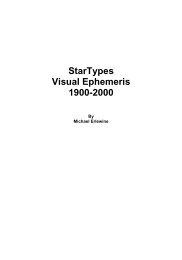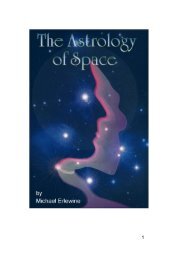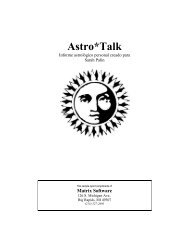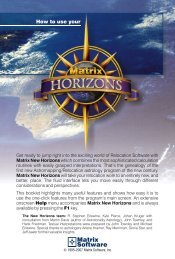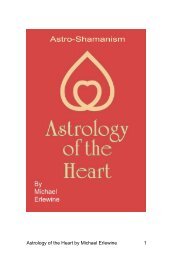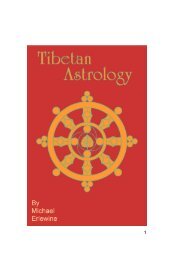- Page 1 and 2:
The Astrology of Space 1
- Page 3 and 4:
The Astrology of Space An ebook fro
- Page 5 and 6:
The Astrology of Space Chapter 1: I
- Page 7 and 8:
The Astrology of Space Solar Apex .
- Page 9 and 10:
The Astrology of Space Chapter 10:
- Page 11 and 12:
The Astrology of Space From the Sky
- Page 13 and 14:
The Astrology of Space SG Seyfert G
- Page 15 and 16:
The Astrology of Space and so on. B
- Page 17 and 18:
The Astrology of Space blackness I
- Page 19 and 20:
The Astrology of Space cosmic event
- Page 21 and 22:
The Astrology of Space learn to kno
- Page 23 and 24:
The Astrology of Space The facts sp
- Page 25 and 26:
The Astrology of Space For example,
- Page 27 and 28:
The Astrology of Space on Earth. An
- Page 29 and 30:
The Astrology of Space shape of the
- Page 31 and 32:
The Astrology of Space As for pract
- Page 33 and 34:
The Astrology of Space Part II: The
- Page 35 and 36:
The Astrology of Space Radio and in
- Page 37 and 38:
The Astrology of Space The Earth's
- Page 39 and 40:
The Astrology of Space than a singl
- Page 41 and 42:
The Astrology of Space radiation, w
- Page 43 and 44:
The Astrology of Space At yet highe
- Page 45 and 46:
The Astrology of Space On the other
- Page 47 and 48:
The Astrology of Space My investiga
- Page 49 and 50:
The Astrology of Space As for the a
- Page 51 and 52:
The Astrology of Space In the begin
- Page 53 and 54:
The Astrology of Space that I was m
- Page 55 and 56:
The Astrology of Space trying to cl
- Page 57 and 58:
The Astrology of Space Mercury (at
- Page 59 and 60:
The Astrology of Space The Sun The
- Page 61 and 62:
The Astrology of Space The Moon Her
- Page 63 and 64:
The Astrology of Space Parallactic
- Page 65 and 66:
The Astrology of Space Venus SS-09
- Page 67 and 68:
The Astrology of Space Mars SS-19 N
- Page 69 and 70:
The Astrology of Space Saturn SS-35
- Page 71 and 72:
The Astrology of Space Neptune SS-5
- Page 73 and 74:
The Astrology of Space Invariable P
- Page 75 and 76:
The Astrology of Space The Asteroid
- Page 77 and 78: The Astrology of Space The Trojan A
- Page 79 and 80: The Astrology of Space Ceres SS-67
- Page 81 and 82: The Astrology of Space Juno SS-83 N
- Page 83 and 84: The Astrology of Space Chapter 3: B
- Page 85 and 86: The Astrology of Space solar activi
- Page 87 and 88: The Astrology of Space There are tw
- Page 89 and 90: The Astrology of Space Famous Meteo
- Page 91 and 92: The Astrology of Space The Head of
- Page 93 and 94: The Astrology of Space (not more th
- Page 95 and 96: The Astrology of Space 53 19101I |H
- Page 97 and 98: The Astrology of Space Near Stars T
- Page 99 and 100: The Astrology of Space and lost fav
- Page 101 and 102: The Astrology of Space The Plane of
- Page 103 and 104: The Astrology of Space Via Combusta
- Page 105 and 106: The Astrology of Space Chapter 5: T
- Page 107 and 108: The Astrology of Space Our Galaxy O
- Page 109 and 110: The Astrology of Space The Galactic
- Page 111 and 112: The Astrology of Space The Location
- Page 113 and 114: The Astrology of Space (including t
- Page 115 and 116: The Astrology of Space How Differen
- Page 117 and 118: The Astrology of Space Interstellar
- Page 119 and 120: The Astrology of Space centimeters
- Page 121 and 122: The Astrology of Space Solar Apex T
- Page 123 and 124: The Astrology of Space The most quo
- Page 125 and 126: The Astrology of Space The Galactic
- Page 127: The Astrology of Space The Galactic
- Page 131 and 132: The Astrology of Space stars. Even
- Page 133 and 134: The Astrology of Space stand up to
- Page 135 and 136: The Astrology of Space Stellar Equi
- Page 137 and 138: The Astrology of Space A Red Giant
- Page 139 and 140: The Astrology of Space A Supernova
- Page 141 and 142: The Astrology of Space pressure and
- Page 143 and 144: The Astrology of Space The Black Ho
- Page 145 and 146: The Astrology of Space Hertzsprung-
- Page 147 and 148: The Astrology of Space Using Stars
- Page 149 and 150: The Astrology of Space B7ne = Spect
- Page 151 and 152: The Astrology of Space Chapter 8: T
- Page 153 and 154: The Astrology of Space Double Stars
- Page 155 and 156: The Astrology of Space Double Stars
- Page 157 and 158: The Astrology of Space Physical Dou
- Page 159 and 160: The Astrology of Space Spectroscopi
- Page 161 and 162: The Astrology of Space Binary Syste
- Page 163 and 164: The Astrology of Space Variable Sta
- Page 165 and 166: The Astrology of Space The Two Type
- Page 167 and 168: The Astrology of Space The RR Lyrae
- Page 169 and 170: The Astrology of Space Semi-Regular
- Page 171 and 172: The Astrology of Space Flare Stars
- Page 173 and 174: The Astrology of Space Novae: Explo
- Page 175 and 176: The Astrology of Space Dwarf Novae
- Page 177 and 178: The Astrology of Space N 03°Sc44'0
- Page 179 and 180:
The Astrology of Space Supernovae T
- Page 181 and 182:
The Astrology of Space The nature o
- Page 183 and 184:
The Astrology of Space star, adding
- Page 185 and 186:
The Astrology of Space been identif
- Page 187 and 188:
The Astrology of Space White Dwarfs
- Page 189 and 190:
The Astrology of Space Wolf-Rayet T
- Page 191 and 192:
The Astrology of Space Thus alpha C
- Page 193 and 194:
The Astrology of Space genitive cas
- Page 195 and 196:
The Astrology of Space 16 Taurus, C
- Page 197 and 198:
The Astrology of Space delta Canes
- Page 199 and 200:
The Astrology of Space beta Bootes,
- Page 201 and 202:
The Astrology of Space 04°Aq10'00
- Page 203 and 204:
The Astrology of Space All objects
- Page 205 and 206:
The Astrology of Space range of 2-6
- Page 207 and 208:
The Astrology of Space Table of Ope
- Page 209 and 210:
The Astrology of Space The Globular
- Page 211 and 212:
The Astrology of Space perhaps fine
- Page 213 and 214:
The Astrology of Space total disint
- Page 215 and 216:
The Astrology of Space Another movi
- Page 217 and 218:
The Astrology of Space O-Associatio
- Page 219 and 220:
The Astrology of Space (Sch) I Lac,
- Page 221 and 222:
The Astrology of Space Chapter 11:
- Page 223 and 224:
The Astrology of Space an otherwise
- Page 225 and 226:
The Astrology of Space Dark Nebulae
- Page 227 and 228:
The Astrology of Space background.
- Page 229 and 230:
The Astrology of Space general, pre
- Page 231 and 232:
The Astrology of Space Radio Sky Th
- Page 233 and 234:
The Astrology of Space Supernova Re
- Page 235 and 236:
The Astrology of Space Radio emissi
- Page 237 and 238:
The Astrology of Space Extragalacti
- Page 239 and 240:
The Astrology of Space Pulsars In t
- Page 241 and 242:
The Astrology of Space Seyfert Gala
- Page 243 and 244:
The Astrology of Space X-Rays, Blac
- Page 245 and 246:
The Astrology of Space X-Ray Points
- Page 247 and 248:
The Astrology of Space discrete sou
- Page 249 and 250:
The Astrology of Space Table of Inf
- Page 251 and 252:
The Astrology of Space Chapter 13:
- Page 253 and 254:
The Astrology of Space hence its en
- Page 255 and 256:
The Astrology of Space of NGC 147,
- Page 257 and 258:
The Astrology of Space Maffei do no
- Page 259 and 260:
The Astrology of Space Two companio
- Page 261 and 262:
The Astrology of Space Direction of
- Page 263 and 264:
The Astrology of Space Clustering A
- Page 265 and 266:
The Astrology of Space The Local Su
- Page 267 and 268:
The Astrology of Space The Virgo Cl
- Page 269 and 270:
The Astrology of Space Galaxies The
- Page 271 and 272:
The Astrology of Space Local Group,
- Page 273 and 274:
The Astrology of Space Chapter 14:
- Page 275 and 276:
The Astrology of Space M-062| 256 3
- Page 277 and 278:
The Astrology of Space Local System
- Page 279 and 280:
The Astrology of Space Our Galaxy 1
- Page 281 and 282:
The Astrology of Space Our SuperGal
- Page 283 and 284:
The Astrology of Space Intersection
- Page 285 and 286:
The Astrology of Space 33 Ascending
- Page 287 and 288:
The Astrology of Space Steps in Map
- Page 289 and 290:
The Astrology of Space 9. The Midhe
- Page 291 and 292:
The Astrology of Space Maps of the
- Page 293 and 294:
The Astrology of Space The Moment o
- Page 295 and 296:
The Astrology of Space The Equatori
- Page 297 and 298:
The Astrology of Space Plotting You
- Page 299 and 300:
The Astrology of Space The Earth’
- Page 301 and 302:
The Astrology of Space 4. At the eq
- Page 303 and 304:
The Astrology of Space axis of the
- Page 305 and 306:
The Astrology of Space Planet Longi
- Page 307 and 308:
The Astrology of Space From the Sky
- Page 309 and 310:
The Astrology of Space From the Sky
- Page 311 and 312:
The Astrology of Space The Ecliptic
- Page 313 and 314:
The Astrology of Space 4. The point
- Page 315 and 316:
The Astrology of Space Ascendant an
- Page 317 and 318:
The Astrology of Space The Ecliptic
- Page 319 and 320:
The Astrology of Space The Ecliptic
- Page 321 and 322:
The Astrology of Space Geographic a
- Page 323 and 324:
The Astrology of Space Circles of L
- Page 325 and 326:
The Astrology of Space North and So
- Page 327 and 328:
The Astrology of Space Longitude an
- Page 329 and 330:
The Astrology of Space expressed in
- Page 331 and 332:
The Astrology of Space 4. All point
- Page 333 and 334:
The Astrology of Space Horizon Sphe
- Page 335 and 336:
The Astrology of Space The Horizon
- Page 337 and 338:
The Astrology of Space The Pole Sta
- Page 339 and 340:
The Astrology of Space 4. These poi
- Page 341 and 342:
The Astrology of Space Ecliptic Coo
- Page 343 and 344:
The Astrology of Space drifted west
- Page 345 and 346:
The Astrology of Space arbitrary re
- Page 347 and 348:
The Astrology of Space Horizon Coor
- Page 349 and 350:
The Astrology of Space East Point -
- Page 351 and 352:
The Astrology of Space and 180° is
- Page 353 and 354:
The Astrology of Space 15. My plane
- Page 355 and 356:
The Astrology of Space words: learn
- Page 357 and 358:
The Astrology of Space or serve as
- Page 359 and 360:
The Astrology of Space galactic or
- Page 361 and 362:
The Astrology of Space Space Coordi
- Page 363 and 364:
The Astrology of Space Connecting t
- Page 365 and 366:
The Astrology of Space on either si
- Page 367 and 368:
The Astrology of Space Chapter 17:
- Page 369 and 370:
The Astrology of Space structure of
- Page 371 and 372:
The Astrology of Space That we may
- Page 373 and 374:
The Astrology of Space Let me put i
- Page 375 and 376:
The Astrology of Space Another way
- Page 377 and 378:
The Astrology of Space a shift in v
- Page 379 and 380:
The Astrology of Space wonderful pr
- Page 381 and 382:
The Astrology of Space Chapter 18:
- Page 383 and 384:
The Astrology of Space South Celest
- Page 385 and 386:
The Astrology of Space DN 07°Pi00'
- Page 387 and 388:
The Astrology of Space G 01°Le54'4
- Page 389 and 390:
The Astrology of Space G 07°Li13'5
- Page 391 and 392:
The Astrology of Space GC 15°Sc57'
- Page 393 and 394:
The Astrology of Space alpha Scorpi
- Page 395 and 396:
The Astrology of Space ME 14°Le08'
- Page 397 and 398:
The Astrology of Space Nova 1942 Pu
- Page 399 and 400:
The Astrology of Space Cepheus-Lace
- Page 401 and 402:
The Astrology of Space 3 Aquila OB
- Page 403 and 404:
The Astrology of Space NGC 2169, lo
- Page 405 and 406:
The Astrology of Space OC 13°Aq19'
- Page 407 and 408:
The Astrology of Space P 06°Pi35'0
- Page 409 and 410:
The Astrology of Space Q 29°Vi33'3
- Page 411 and 412:
The Astrology of Space R 21°Le23'3
- Page 413 and 414:
The Astrology of Space (optical 192
- Page 415 and 416:
The Astrology of Space 1914 A (Feb-
- Page 417 and 418:
The Astrology of Space SS 21°Ge46'
- Page 419 and 420:
The Astrology of Space Descending S
- Page 421 and 422:
The Astrology of Space VB 27°Sc35'
- Page 423 and 424:
The Astrology of Space X 09°Sa25'1
- Page 425 and 426:
The Astrology of Space Chapter 19:
- Page 427 and 428:
The Astrology of Space With IF exce
- Page 429 and 430:
The Astrology of Space G 27°Ar09'2
- Page 431 and 432:
The Astrology of Space FS 07°Ta54'
- Page 433 and 434:
The Astrology of Space R 21°Ta00'3
- Page 435 and 436:
The Astrology of Space WD 29°Ta38'
- Page 437 and 438:
The Astrology of Space Spectroscopi
- Page 439 and 440:
The Astrology of Space DI 22°Ge25'
- Page 441 and 442:
The Astrology of Space R 03°Cn27'2
- Page 443 and 444:
The Astrology of Space OA 18°Cn47'
- Page 445 and 446:
The Astrology of Space Pup, (Ru) Pu
- Page 447 and 448:
The Astrology of Space AUSTRALIS, (
- Page 449 and 450:
The Astrology of Space LG 05°Vi39'
- Page 451 and 452:
The Astrology of Space FS 19°Vi36'
- Page 453 and 454:
The Astrology of Space Abell 1656 C
- Page 455 and 456:
The Astrology of Space P 08°Li32'6
- Page 457 and 458:
The Astrology of Space Irregular, t
- Page 459 and 460:
The Astrology of Space Concentrated
- Page 461 and 462:
The Astrology of Space G 26°Sc50'3
- Page 463 and 464:
The Astrology of Space FS 08°Sa32'
- Page 465 and 466:
The Astrology of Space FS 18°Sa40'
- Page 467 and 468:
The Astrology of Space OC 28°Sa31'
- Page 469 and 470:
The Astrology of Space N 04°Cp43'0
- Page 471 and 472:
The Astrology of Space FS 15°Cp07'
- Page 473 and 474:
The Astrology of Space Aquarius FS
- Page 475 and 476:
The Astrology of Space R 13°Aq27'2
- Page 477 and 478:
The Astrology of Space Austrinus, (
- Page 479 and 480:
The Astrology of Space FS 18°Pi32'
- Page 481 and 482:
The Astrology of Space Michael Erle
- Page 483 and 484:
The Astrology of Space Example Astr
- Page 485 and 486:
The Astrology of Space The Heart Ce
- Page 487 and 488:
The Astrology of Space The All-Musi
- Page 489 and 490:
The Astrology of Space collection i
- Page 491 and 492:
The Astrology of Space involved wit
- Page 493 and 494:
The Astrology of Space In 1965, the






